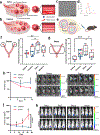Nanomedicine for Maternal and Fetal Health
- PMID: 37817368
- PMCID: PMC11004090
- DOI: 10.1002/smll.202303682
Nanomedicine for Maternal and Fetal Health
Abstract
Conception, pregnancy, and childbirth are complex processes that affect both mother and fetus. Thus, it is perhaps not surprising that in the United States alone, roughly 11% of women struggle with infertility and 16% of pregnancies involve some sort of complication. This presents a clear need to develop safe and effective treatment options, though the development of therapeutics for use in women's health and particularly in pregnancy is relatively limited. Physiological and biological changes during the menstrual cycle and pregnancy impact biodistribution, pharmacokinetics, and efficacy, further complicating the process of administration and delivery of therapeutics. In addition to the complex pharmacodynamics, there is also the challenge of overcoming physiological barriers that impact various routes of local and systemic administration, including the blood-follicle barrier and the placenta. Nanomedicine presents a unique opportunity to target and sustain drug delivery to the reproductive tract and other relevant organs in the mother and fetus, as well as improve the safety profile and minimize side effects. Nanomedicine-based approaches have the potential to improve the management and treatment of infertility, obstetric complications, and fetal conditions.
Keywords: infertility; obstetrics; pregnancy; vaginal drug delivery; women's health.
© 2023 Wiley‐VCH GmbH.
Conflict of interest statement
Conflict of Interest
The mucus-penetrating particle technology is licensed and in clinical development for ocular indications by Kala Pharmaceuticals. L.M.E and Johns Hopkins own company stock. Under a licensing agreement between Kala Pharmaceuticals and the Johns Hopkins University, L.M.E. and the University are entitled to royalty distributions related to the technology. These arrangements have been reviewed and approved by the Johns Hopkins University in accordance with its conflict of interest policies. All authors contributed to the manuscript, assisted in revisions, read, and approved the submitted version.
Figures





Similar articles
-
Rational Design of Nanomedicine for Placental Disorders: Birthing a New Era in Women's Reproductive Health.Small. 2024 Oct;20(41):e2300852. doi: 10.1002/smll.202300852. Epub 2023 May 16. Small. 2024. PMID: 37191231 Review.
-
Design of nanomaterials for applications in maternal/fetal medicine.J Mater Chem B. 2020 Aug 21;8(31):6548-6561. doi: 10.1039/d0tb00612b. Epub 2020 May 26. J Mater Chem B. 2020. PMID: 32452510 Free PMC article. Review.
-
The Application of Engineered Nanomaterials in Perinatal Therapeutics.Small. 2024 Oct;20(41):e2303072. doi: 10.1002/smll.202303072. Epub 2023 Jul 12. Small. 2024. PMID: 37438678 Review.
-
Drug delivery during pregnancy: how can nanomedicine be used?Ther Deliv. 2017 Dec;8(12):1023-1025. doi: 10.4155/tde-2017-0084. Ther Deliv. 2017. PMID: 29125062 No abstract available.
-
Targeted drug delivery for maternal and perinatal health: Challenges and opportunities.Adv Drug Deliv Rev. 2021 Oct;177:113950. doi: 10.1016/j.addr.2021.113950. Epub 2021 Aug 26. Adv Drug Deliv Rev. 2021. PMID: 34454979 Free PMC article. Review.
Cited by
-
Engineering nanosystems for regulating reproductive health in women.Theranostics. 2025 Jan 1;15(2):439-459. doi: 10.7150/thno.102626. eCollection 2025. Theranostics. 2025. PMID: 39744682 Free PMC article. Review.
-
Fetus Exposure to Drugs and Chemicals: A Holistic Overview on the Assessment of Their Transport and Metabolism across the Human Placental Barrier.Diseases. 2024 Jun 1;12(6):114. doi: 10.3390/diseases12060114. Diseases. 2024. PMID: 38920546 Free PMC article. Review.
References
-
- Hoekzema E et al., Pregnancy leads to long-lasting changes in human brain structure. Nat Neurosci 20, 287–296 (2017). - PubMed
-
- Chandra A, Copen CE, Stephen EH, Infertility and impaired fecundity in the United States, 1982–2010: data from the National Survey of Family Growth. Natl Health Stat Report, 1–18, 11 p following 19 (2013). - PubMed
-
- Ventura SJ, Curtin SC, Abma JC, Henshaw SK, Estimated pregnancy rates and rates of pregnancy outcomes for the United States, 1990–2008. Natl Vital Stat Rep 60, 1–21 (2012). - PubMed
Publication types
MeSH terms
Grants and funding
LinkOut - more resources
Full Text Sources

